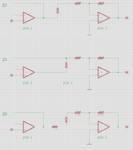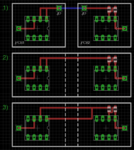juz_ad
Full Member level 2
I have a PCB design that uses 2x different boards with an inter-board connector between them. I've realised that I might have done something stupid with the trace/layout that one of the connectors is using - hopefully the pic should explain it...

v1) PCB 1 has an op-amp buffer, the output goes to an inter-board connector which then goes to the input of an inverting op-amp config on PCB 2.
v2) Am I right that - as far as the circuit/layout is concerned - that buffer feedback loop essentially runs all the way to the input of the op-amp on the 2nd PCB and back again?
v3) How do I stop that? Would putting a R right at the buffer output and then, if necessary, compensating with an R in the gain of the next, inverting op-amp?
Would that put the buffer feedback loop only on PCB 1? Hope that's clear/makes sense.
Thanks in advance.
/ J

v1) PCB 1 has an op-amp buffer, the output goes to an inter-board connector which then goes to the input of an inverting op-amp config on PCB 2.
v2) Am I right that - as far as the circuit/layout is concerned - that buffer feedback loop essentially runs all the way to the input of the op-amp on the 2nd PCB and back again?
v3) How do I stop that? Would putting a R right at the buffer output and then, if necessary, compensating with an R in the gain of the next, inverting op-amp?
Would that put the buffer feedback loop only on PCB 1? Hope that's clear/makes sense.
Thanks in advance.
/ J
